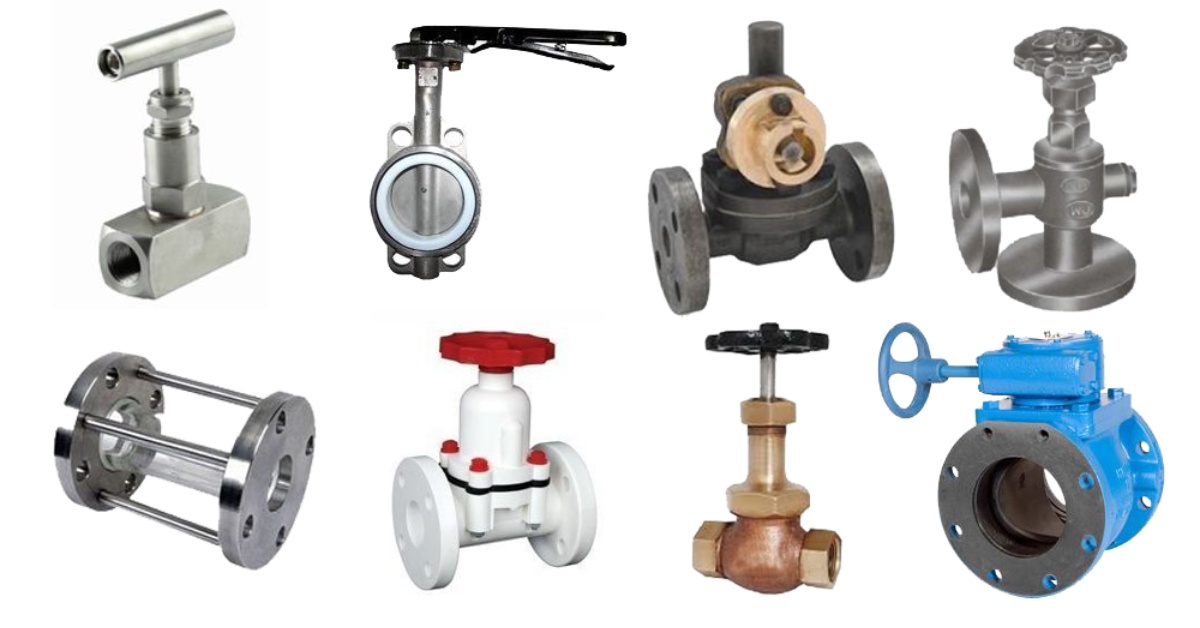Choosing the appropriate valves to suit your requirements can feel overwhelming due to the abundance of options in terms of types and sizes. Industrial valves encompass a wide range, including check valves, relief valves, ball valves, gate valves, globe valves, plug valves, and butterfly valves, offering a comprehensive selection to cater to diverse industrial applications.
Within this blog, we will provide an overview of various valve types along with their respective applications. By delving into the details, we aim to empower you to make well-informed decisions that align with your specific needs.
Every type of valve possesses its own set of advantages and disadvantages. Valves employ various mechanisms such as plates, balls, and diaphragms as mechanical barriers. These barriers can be inserted or removed within a flowing material stream, depending on the valve design. Some valves allow for manual on/off switching, while others offer automatic control for precise regulation. The selection of valve materials plays a crucial role in ensuring compatibility with liquids or powders passing through the valve's wetted parts. Additionally, factors such as pipe diameter, fluid/gas flow rate, pressure, and the distance between valve flanges are vital considerations when determining the appropriate valve for a given application.
Classification of the Valves:
Valves can be classified based on their function, operating principle, and construction. In the market, you can find a variety of common types of industrial valves, including:
- Ball Valves
- Butterfly Valves
- Check Valves
- Diaphragm Valves
- Plug Valves
Why are valves used?
- Flow Interruption and Control:
- Pressure Regulation:
- Mixing of Solids and Liquids:
- Directional Control:
- Safety and Protection:
- Process Control:
Valve Applications, Benefits, and Drawbacks
The market is filled with a wide variety of valves. Each has its own set of advantages, disadvantages, and applications. Here are some details about it:
Ball Valves
These are some of the most popular valves because of their dependability and straightforward design. A ball valve is a sphere in the form of a disc that has an opening or closing mechanism to control fluid flow. A ball is an object that is cylindrical in shape and has a handle connected to it that fits through the centre hole.
When the handle is twisted, the ball rotates, opening or closing the valve. High pressure can be handled and ball valves are quite dependable. Slurries and other solid suspensions should not be used with them because they have a tendency to clog.
Advantages:
- Ball valves are simple to use. The handle can be used to control them. To open or close the valve, rotate it.
- They are therefore perfect for uses that demand quick, frequent operation.
- Ball valves are perfect for important applications because they can resist constant use and abuse.
Disadvantages:
- Ball valves can cost more than other types of valves.
- Since they are only capable of being fully open or fully closed, they are not appropriate for applications requiring a very precise degree of control.
Applications:
- For normal, corrosive, and slurries, the ball valves cut off and control flow and pressure.
- They work in a variety of industry settings, chemical storage facilities, residential settings, and other applications in the natural gas and oil industries.
Butterfly Valves
These butterfly valves could be used in places where there is a paucity of space. Simple opening and closing mechanisms are used by this valve. It allows or restricts fluid flow. These valves resemble ball valves in many ways, with the exception that a disc, not a ball, is fastened to the handle. The disc cannot rotate to open or close the valve. It instead oscillates up and down.
Suitable for use in situations requiring a compact footprint, butterfly valves are smaller in size. They are more susceptible to damage from high pressure and less resilient than ball valves.
Advantages:
- The primary benefit of butterfly valves is their low cost.
- They are a common option for many businesses because they are simple to set up and manage.
- Butterfly valves can be mounted either vertically or horizontally.
Disadvantages:
- Butterfly Valves are cost-effective and capable of handling high flow rates. They are suitable for high-pressure applications because of this.
Applications:
- The processing of food, medications, and chemicals are among the uses for the butterfly valve.
- They can be utilised with corrosive liquids at low pressures and temperatures.
Check Valves
There are many different types of valves on the market, each with a special purpose. Reverse flow can be stopped with these valves.
When fluid flows in the opposite direction from where it was intended, it is known as backflow or reverse flow. This may occur if the system suddenly loses pressure or if something downstream obstructs fluid passage. To avoid backflow, a check valve needs to be able to open and close quickly.
Advantages:
- Check valves prevent backflow and serve as a failsafe.
- They are pressure-resistant.
Disadvantages:
- They are not compatible with pulse systems.
- The closing component could collide, resulting in overuse and damage.
Applications:
- Check due to the variety of materials readily available and their simple construction.
- There are several uses and industries that use valves.
- They help to maintain pressure by preventing backflow.
- They are also utilised in industrial and wastewater management procedures.
Diaphragm Valves
Diaphragm valves are widely used in various industries for their unique design and functional advantages. Let's explore their applications, benefits, and drawbacks:
Advantages:
- Precise Control
- Good Sealing Capability
- Resistant to Corrosion and Abrasion
- Sterilizable and Sanitary
- Low Maintenance
Disadvantages:
- Flow Restriction
- Limited Pressure and Temperature Range
- Potential for Wear and Tear
Applications:
- Pharmaceutical and Biotech Industries
- Water and Wastewater Treatment
- Food and Beverage Industry
- Chemical Processing
- Mining and Slurry Handling
Plug Valves
Another form of valve that can be used to control fluid flow is the plug valve. These valves carry out the task using a ported plug. To limit or permit flows, you can pivot the flows. You need to be aware of the kind, size, connections, makeup, and port configuration of your valve. To turn the system off, use the plug valve. It can be utilised as a control valve in chemical industries, wastewater treatment facilities, and processing plants.
Advantages:
- Plug valves have a small number of pieces and are incredibly simple to construct.
- Despite being small, they are quite easy to open and close.
- When necessary, plug valves can be repaired or maintained on-site.
- These valves provide less flow resistance.
- Plug valves are dependable and capable of stopping leaks.
Disadvantages:
- For the valve's initial movement (opening or closing), there must be a lot of friction.
- For large-size valves, an actuator-equipped gearbox is necessary.
- The flow can narrow as a result of plugs.
- Generally speaking, ball valves are less expensive than plug valves.
Applications:
Plug valves are useful for regulating flow. They can be utilised with potentially dangerous liquids and aggressive gases, for example. The following are some uses for plug valves that valve manufacturers can make advantage of:
- systems for piping oil
- Systems for high-pressure flows and extreme temperatures
- chemical maintenance
- handling corrosive chemicals.
Conclusion
Valves are utilised in a multitude of industries, including plumbing and the automotive industry, and are essential components of many systems. It's critical to comprehend how valves work because there are several varieties. This will enable you to choose the ideal industrial valve for your needs.
We hope that this blog post has increased your awareness of the different types of valves available on the market and given you a better notion of which will best suit your needs.


No comments yet